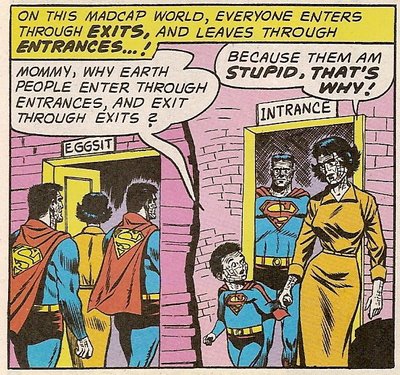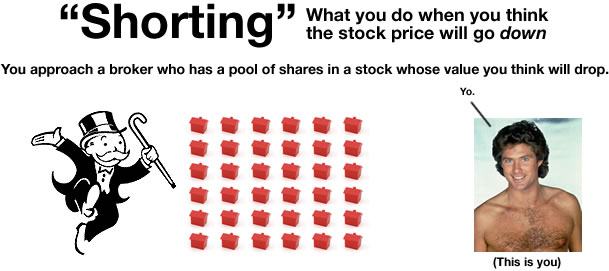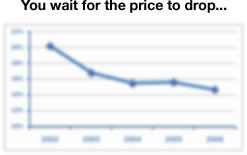It’s quite telling that almost every article on the recent restrictions on short selling (or “shorting”) stocks includes a couple of paragraphs explaining what short selling is. The shortest explanation — “It’s making money by betting that a stock will go down” — is counterintuitive. The English idiom “to sell something/someone short” adds to the confusion, because it means “to underestimate the value of something/someone”, which is essentially the opposite of short selling.
In this article, I’m going to explain the basics of short selling and give you enough background material for you to read articles about the current state of the financial world without getting complete confused. And yes, I’ll make it fun.
Stock Market Jargon, Applied to Dating
About five years ago, I attended a gala and at one point had the accordion-assisted privilege of enjoying some cocktails with some very pretty ladies, an event I chronicled in this entry.
An excerpt:
At one point in the evening, I was having some Campari-and-sodas with a group of charming young women, all of whom were wearing The Little Black Dress. The one who was sitting beside me cupped her hand, turned to me and whispered “See that guy? My friend Lisa* longs him.”
(* Not her real name.)
I interpreted “longs” as “longs for”. However, later on in the conversation, some guy took a seat beside Lisa and started hitting on her with the grace of a rhino on NyQuil.
“Ugh,” said She Who Sat Beside Me. “She really shorts him. I think we’re all shorting him.”
That’s when it clicked. The girls all worked in the financial industry together; in fact, it seemed that most of the attendees at the gala were in finance or had at least written their CFA exam.
They’d adopted the terms longing and shorting for dating. If they liked someone, they “longed” him; if they didn’t, they “shorted” him.
The blog entry caught the attention of Globe and Mail editor Carol Toller and ended up being a short piece in the Our Town section in January 2004. This appearance gave it considerably more exposure, and for the next little while, I was approached by a number of friends and readers who suggested that I write an article explaining longing and shorting. I thought it was a good idea, and it sat in my “things to blog about” list for the next five years.
With the recent events on Wall Street, most notably the current ban on short selling shares of specific financial institutions, I thought that now might be a good time to take that article off the “to do” list and make it real.
“Longing”
This is the form of investing that makes intuitive sense. In longing, a.k.a. “buying long” or “going long”, you buy shares in a stock that you think will go up in value. At some later time, you sell them for more than you paid for them, and thus you make a profit.

Once more, with feeling:
- You buy some shares at a low price
- You wait for their price to increase
- You sell the shares at a higher price
The concept is so simple that I’m pretty sure that you already knew what longing was, even if you were unaware of the term.
It’s usually after this explanation of longing that people ask “Then how can you possibly make money on a stock that loses value? You’d have to be on the Bizarro World!”
To which I’d answer: “Exactly.”
Introducing Bizarro World!
Superman comics in the 1950s and 1960s were full of some painfully, stool-softeningly dumb ideas. One of them was the Bizarro World, the home of imperfect duplicates of Superman and Lois Lane, where everything is backwards.
On the Bizarro World, you enter through the exit and exit through the entrance:

You demonstrate affection by throwing tantrums on Bizarro World:

You win Bizarro World races by coming in last place:

On one Superman comic, Bizarro bonds are shown to be selling like hotcakes because they’re guaranteed to go down in value.
Since everything is (somewhat inconsistently) backwards in the Bizarro World, you, as a Bizarro investor might try to “go long” in reverse order:
- You sell the shares at a higher price
- You wait for their price to decrease
- You buy some shares at a low price
Believe it or not, that’s how shorting works.
Shorts Illustrated
Since the Bizarro World doesn’t exist, we’ll have to accept a couple of real world constraints.
The first is finding a way to sell shares you don’t own. In “regular” shorting (a.k.a. “covered” shorting), you borrow the shares from a broker who would typically have a lot of them and is willing to lend them out for a fee. (There is a way to sell shares you don’t own without first borrowing some. It’s called naked shorting and it’s the “extreme sports” of short selling.)
The second is to make sure that enough people in the market think that in the long term, the share value of the stock will go up. The broker keeps a pool of those stocks because s/he thinks that in the long term, they will appreciate. S/he’s happy to lend them out to short sellers who are planning to make money on the occasional dip in value, but believes that its price’s trend over time is upward.
And now, the basics of shorting, with special guest stars The Monopoly Guy and Mr. David Hasselhoff:






Recommended Reading
Now that you’ve got the basics of shorting, you can read about the details that I didn’t cover. Some good places to start are:
- Wikipedia’s explanation of shorting. In the past week it’s been updated quite often, thanks to the current market kerfuffle.
- Naked shorting, as explained by Wikipedia. “Naked shorting” sounds like some kind of porn term, but it ain’t. At least not yet.
- The Motley Fool’s FAQ on shorting. A nice explanation by one of the best-known investment sites.
- Short Selling and the Death of Satire: This article from July in funny-sad in hindsight. The author laments the planned crackdowns on short selling back then, saying that the “delicate flowers” that the measure is supposed to protect are big strong places like…Lehman Brothers!
- Short-selling: A User’s Guide. An article in today’s edition of the Australian paper The Age.
- How Does Short Selling Work? A quick explanation from investored.ca.
- SEC imposes emergency ban on short-selling
- OSC follows SEC in easing short-selling ban to fix ‘technical concerns’
- Will short-selling ban help – or hurt – banks?
6 replies on “What is “Short Selling”?”
Excellent, Joe. i finally understand.
tv
Given my height I am always selling short.
The English idiom “to sell something/someone short” adds to the confusion, because it means “to underestimate the value of something/someone”,
Not really. You say “Don’t sell yourself short” when someone underestimates themselves because they are assigning a low value to their own ability to perform (in the future). “Selling short” in this phrase means the same as it does in the stock market — it’s the “don’t” that indicates that you think the person is underestimating themselves, not the “sell yourself short.”
Selling short is depicted in that classic film, Trading Places.
[…] of mine who works in finance — I’ll call him “Senor Gumbo” — to my earlier post in which I explained “longing” and “shorting” to see if I’d explained it properly. He said that I’d nailed it, but he also said that […]
thanks. now i get it. but why does the broker let himself be manipulated like that?